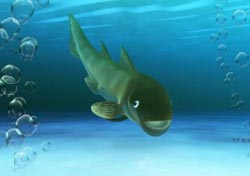A new species of marine fish from 408 million years ago discovered in Teruel

This is Machaeracanthus goujeti.<br>Credit: SINC<br>
In the journal 'Geodiversitas', a research team led by the University of Valencia describes a new species of spiny shark (Acanthodii), a primitive type of fish that shared characteristics with sharks and bony fish.
Remains of scales, bones and scapular joint bones were found in Devonian (approximately 408 million years ago) in Teruel and the south of Zaragoza. The paper also includes an analysis of fossils of a fragmented spine and isolated scales from the Lower Devonian found in northern Spain (Palencia and Cantabrian Mountains) and western France (Saint-Céneré commune), originally attributed to the Machaeracanthus sp species.
“The discovery of this new species, which we call Machaeracanthus goujeti and belongs to the Acanthodii group –of which very little is known–, expands our knowledge of the biodiversity that existed on the peninsula 480 million years ago, when the modern-day region of Teruel was covered by the sea,” Héctor Botella, professor in the palaeontology unit in the University of Valencia and the study's lead author, explained to SINC.
The Acanthodii group of fish are also known as 'spiny sharks' owing to their appearance and, from what we know to date, they only lived during the Palaeozoic Era and reached their maximum level of diversity in the Devonic period.
However, the bones typically found in the Acanthodii group grow differently to the bones found, therefore this type could be even more similar to sharks and would date from the very early stages of the radiation of jawed vertebrates (gnathostomata).
A fish fossil no more than one metre in length
The majority of the samples found by the researchers are juveniles. Based on the fossilised remains, the researchers estimate that the largest fish in this species would not reach one metre in length. “This is just an estimation because there are animals that can have large bones and be small, and vice versa,” Botella stated.
For their part, the fossils found in the sediment layers of the Iberian mountain range must surely have belonged to fish that swam close to the coast. “In other words, they must have lived in an epicontinental sea –an extensive but shallow salt water mass–, and it is therefore possible that this area was used as a breeding ground,” he concludes. Larger fossils were found in sediment layers a little further down.
The fossils form part of the collection housed in the Palaeontology Museum of Zaragoza.
References:
Héctor Botella, Carlos Martínez-Pérez, Rodrigo Soler-Gijón “Machaeracanthus goujeti n. sp. (Acanthodii) from the Lower Devonian of Spain and northwest France, with special reference to spine histology”, Geodiversitas, 34(4):761-783, 2013.
Media Contact
More Information:
http://www.agenciasinc.esAll latest news from the category: Earth Sciences
Earth Sciences (also referred to as Geosciences), which deals with basic issues surrounding our planet, plays a vital role in the area of energy and raw materials supply.
Earth Sciences comprises subjects such as geology, geography, geological informatics, paleontology, mineralogy, petrography, crystallography, geophysics, geodesy, glaciology, cartography, photogrammetry, meteorology and seismology, early-warning systems, earthquake research and polar research.
Newest articles

Machine learning algorithm reveals long-theorized glass phase in crystal
Scientists have found evidence of an elusive, glassy phase of matter that emerges when a crystal’s perfect internal pattern is disrupted. X-ray technology and machine learning converge to shed light…

Mapping plant functional diversity from space
HKU ecologists revolutionize ecosystem monitoring with novel field-satellite integration. An international team of researchers, led by Professor Jin WU from the School of Biological Sciences at The University of Hong…

Inverters with constant full load capability
…enable an increase in the performance of electric drives. Overheating components significantly limit the performance of drivetrains in electric vehicles. Inverters in particular are subject to a high thermal load,…





















